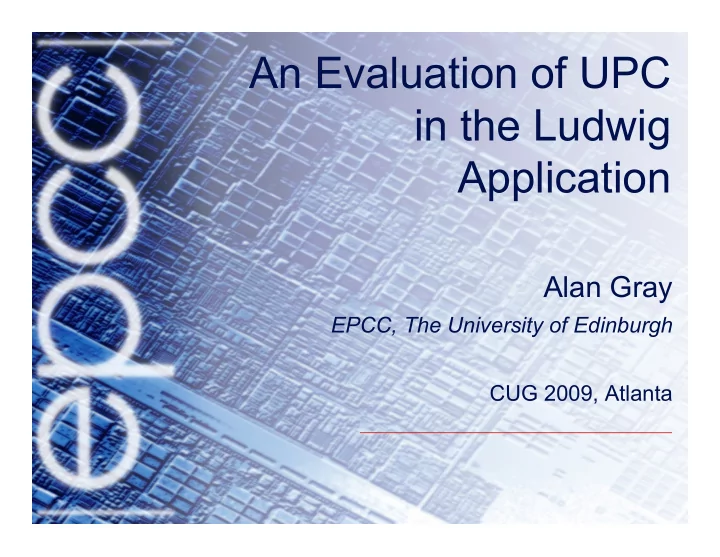

An Evaluation of UPC in the Ludwig Application Alan Gray EPCC, The University of Edinburgh CUG 2009, Atlanta
Introduction • Modern HPC architectures comprise multiple nodes – connected via interconnect • Applications must utilise these multiple nodes to solve single problem – Mechanism needed for each process to acquire remote data • Message passing (MPI) has become de-facto standard – need for complex coding to manage the message passing – performance overheads due to underlying 2-way communication • Novel PGAS languages offer intuitive access of remote data – Potentially increase productivity and performance in HPC • UPC (arguably) most mature and portable PGAS language today 4 th May 2009 CUG 2009, Atlanta 2
Introduction (cont.) • AIM: evaluate UPC as a replacement of MPI within real application (LUDWIG) – measure performance • Full conversion beyond scope of work – But UPC and MPI can co-exist: can target area of interest • UPC fully supported at hardware level on Cray X2 – This study uses X2 component of HECToR (112 processors) – UPC will be fully supported on XT after upgrade to GEMINI interconnect 4 th May 2009 CUG 2009, Atlanta 3
UPC • Consider simplistic case: 8 elements distributed between 2 processes – Where updates require neighbouring values • Regular C array (local): int p[6]; • UPC shared array (global): shared [8/THREADS] int s[8]; 4 th May 2009 CUG 2009, Atlanta 4 4
LUDWIG • LUDWIG uses Lattice-Boltzmann models to enable simulation of hydrodynamics of complex fluids (mixtures of fluids, solids/fluids) in 3D – Jean Christophe Desplat, Dublin Institute for Advanced Studies – Kevin Stratford, Mike Cates, The University of Edinburgh – Applications include personal care products, e.g. shampoo 4 th May 2009 CUG 2009, Atlanta 5
LUDWIG • Original Code: – Halo cells only accessed in Propagation 4 th May 2009 CUG 2009, Atlanta 6
LUDWIG Conversion • Main data structure is array site[] , where – each element corresponds to a lattice site – consists of a struct containing physical variables • Original Code Propagation section: updates require values from neighbouring sites Loop over index … site[index].f[0]=site[index-1].f[0]+…; … • Halo cells + message passing halo swap routines required 4 th May 2009 CUG 2009, Atlanta 7
LUDWIG Conversion • Strategy: mirror site with UPC Shared structure s_site . – New functionality: sindex[index] Mapping of local ( site ) - global ( s_site ) index put_site_in_shared() Copy data local -> shared get_site_from_shared() Copy data shared -> local • Allows for specific area of application to be targeted – Propagation section adapted to work with shared arrays Loop over index … s_site[sindex[index]].f[0] =s_site[sindex[index-1]].f[0]+…; … • No halo cells/swaps needed, remote accesses done directly 4 th May 2009 CUG 2009, Atlanta 8
LUDWIG Conversion • Modified LUDWIG code: 4 th May 2009 CUG 2009, Atlanta 9
Performance results 4 th May 2009 CUG 2009, Atlanta 10
Performance results 4 th May 2009 CUG 2009, Atlanta 11
Performance results • Naïve adaptation has substantial negative impact • Underlying communication is not cause of this • Shared pointer dereferencing more costly than for regular pointers • Optimised version: access memory through regular C pointers where possible – Obtained by casting from shared pointers – Boundary updates must still use shared array accesses to get remote data. 4 th May 2009 CUG 2009, Atlanta 12
Performance results 4 th May 2009 CUG 2009, Atlanta 13
Conclusions • UPC allows for intuitive access to remote data – Potentially increasing performance and productivity in HPC • LUDWIG adapted to utilise UPC functionality – Focusing on key section – Shared structures remove need for complicated halo swaps • Significant performance degradation with naïve adaptation – Due to sensitivity to costly shared pointer operations • Optimised version uses regular C pointers to access data where possible – Performs similarly to (but slightly worse than) MPI version – remaining degradation likely due to remaining shared pointer operations • Would be interesting to test on larger system (inc. future Cray XT) 4 th May 2009 CUG 2009, Atlanta 14
Recommend
More recommend